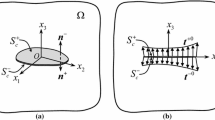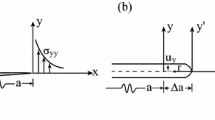Abstract
The novelty of the approach contains several aspects: the method of derivation of the governing equations, the form and number of equations, the optimal choice of elastic constants. While majority of published articles derives the governing equations from the Green’s function for the compound space and the use of the reciprocal theorem, we use the combination of Green’s functions for 2 different half-spaces and Fourier transform. The usual approach leads to 3 hypersingular integral equations, we arrive at 2 integro-differential equations (one of them being complex). While the coefficients of the governing equations in existing publications are presented in terms of the results of the solution of a set of linear algebraic equations and are too cumbersome to be written explicitly in terms of the basic elastic constants, our choice of the basic constants leads to quite elegant explicit expressions for these coefficients and reveals certain symmetry, which was noticed only numerically in previous publications. The new form of the governing equations allows us to obtain an exact closed form solution for an axisymmetric interface crack problem by elementary means. The same method can be applied to obtain the exact solution for a non-axisymmetric problem. A comparison is made with the existing exact solutions and some are shown to be incorrect.
Similar content being viewed by others
References
Fabrikant, V.I.: Contact and Crack Problems in Linear Elasticity. fabrikant-research.webs.com (2010)
Fabrikant, V.I.: Bonded contact and general crack problems in generalized materials and their relationships. Meccanica 53, 2709–2723 (2018)
Kassir, M.K., Bregman, A.M.: The stress intensity factor for a penny-shaped crack between two dissimilar materials. J. Appl. Mech. 39, 308–310 (1972)
Keer, L.M.: Mixed boundary-value problems for an elastic half-space. Proc. Camb. Philos. Soc. 63, 1379–1386 (1967)
Kryvyi, O.F.: Circular interface crack in the inhomogeneous transversely isotropic space. Mater. Sci. 47(6), 726–736 (2012)
Lowengrub, M., Sneddon, I.N.: The effect of shear on a penny-shaped crack at the interface of an elastic half-space and a rigid foundation. Int. J. Eng. Sci. 10, 899–913 (1972)
Lowengrub, M., Sneddon, I.N.: The effect of internal pressure on a penny-shaped crack at the interface of two bonded elastic half-spaces. Int. J. Eng. Sci. 12, 387–396 (1974)
Lowengrub, M., Walton, J.R.: A note on the asymptotic expansion of an integral occurring in the analysis of certain bi-media crack problems. Int. J. Eng. Sci. 22, 707–710 (1984)
Mossakovskii, V.M., Rybka, M.T.: Generalization of the Griffith–Sneddon criterion to the case of inhomogeneous body. Prikl. Math. Mekh 28(6), 1061–1069 (1964)
Saxena, H.S., Dhaliwal, R.S.: A penny-shaped crack at the interface of two bonded dissimilar transversely isotropic elastic half-spaces. Eng. Fract. Mech 37(4), 891–899 (1990)
Tikhomirov, V.V.: An interfacial crack in a transversely isotropic composite medium. J. Appl. Math. Mekh. 60(5), 833–838 (1996)
Willis, J.R.: The penny-shaped crack on an interface. Q. J. Mech. Appl. Math. 25, 367–385 (1972)
Zhao, M.H., Li, D.X., Shen, Y.P.: Interfacial crack analysis in three-dimensional transversely isotropic bi-materials by boundary integral equation method. Appl. Math. Mech. Engl. Ed. 26(12), 1539–1546 (2005)
Acknowledgements
The author expresses his gratitude to his son Isaac for help in various computations and for preparation of this article for publication.
Author information
Authors and Affiliations
Corresponding author
Additional information
Publisher's Note
Springer Nature remains neutral with regard to jurisdictional claims in published maps and institutional affiliations.
Appendices
Appendix 1
We present below the table of Fourier integral transforms, used in this article.
The following notation was introduced in the formulas above:
Appendix 2
We present below the solutions of the set of linear algebraic equations (58–63)
The solutions for \(B_{kj}\) are exactly the same as for \(A_{kj}\) given above, except that the coefficients \(A_{k}^{+}\) should be replaced by \(-B_{k}^{+}\) for \(\{j,k\}=1,2\). The solutions for \(B_{3}\) are
Rights and permissions
About this article
Cite this article
Fabrikant, V.I. New approach to interface crack problems in transversely isotropic materials. Z. Angew. Math. Phys. 72, 86 (2021). https://doi.org/10.1007/s00033-020-01445-y
Received:
Revised:
Accepted:
Published:
DOI: https://doi.org/10.1007/s00033-020-01445-y




